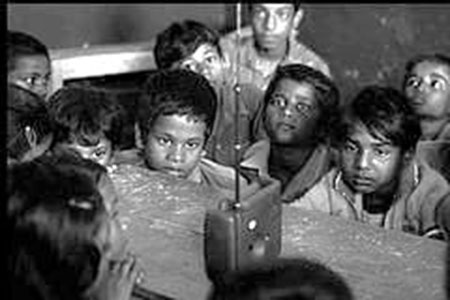4 Radio as a classroom resource
Case Study 3: Using radio for language and literacy development
Mrs Rekha is a multi-grade teacher in in a rural primary school in Bihar. Here she describes how she uses radio as a resource in her language lessons.
My school has very few resources apart from the textbooks provided. I listen to the radio a great deal in my free time and have discovered a wide range of interesting programmes. I now regularly use the radio as an additional source of input in my students’ language lessons. I like the way it enables me to expose them to the world outside the classroom.
I use the radio programme guide in the newspaper to identify suitable programmes, based on the topics they will cover. I used to broadcast programmes directly in the classroom so needed to make sure that the timing was suitable, but now I have a radio with a recording facility, so I can select them in advance and replay them later.
I often get my students to listen to especially made educational programmes, because these are clearly presented and include one or two short comprehension tasks or other activities. We always spend time talking about the content of the programme afterwards. This is helpful in clarifying anything that hasn’t been understood. Sometimes we do this as a whole class. Sometimes I group my students and ask them to discuss the programme together. I usually follow up these discussions by asking my younger students to write a short text on the content of the programme and my older ones to write a longer report.
I also broadcast stories, plays and soap operas in the classroom. These lend themselves to discussions about the characters, the issues raised, or what might happen next. I sometimes invite my students to write out dialogues in their own words and act them out in role plays.
I like the way radio programmes expose my students to different voices, new expressions and different registers of language. During the programmes I note down any possible unfamiliar words and ask my students afterwards if they know, or can guess, what they mean. Sometimes they comment on the language they hear, pointing out that the presenter has pronounced a word in a particular way or used a word or expression when they would have used an alternative. Discussing these differences helps raise their awareness of the richness and variety of language.
I have also experimented with broadcasting a short section of a programme in one of my students’ home languages. I asked those who could understand it to explain to their classmates what the speaker said. I then asked them to repeat two or three of the key words that the speaker used and invited the rest of the class to repeat them orally. They wrote the words that they knew in their home language on the board and the rest of the class copied them into their exercise books. Everyone was very absorbed in this lesson.
For my students, using radio broadcasts complements listening to me all the time.
Pause for thought
|
The key resource ‘Involving all [Tip: hold Ctrl and click a link to open it in a new tab. (Hide tip)] ’ contains more ideas on how to increase student participation in the classroom by valuing their home languages, for example.
Activity 4: Using radio in your classroom
It is helpful to practise exploiting radio programmes for language and literacy development before you try using them in class.

Over a period of a week or so, take time to listen to two or three radio programmes that you think could be suitable for your students. As you listen to them, think about what you want your students gain from the broadcast in terms of:
- aspects of its content
- their language and literacy development.
Next, imagine taking the class and rehearse aloud the kinds of questions and discussion points that you might raise with your students after the broadcast, taking into account their knowledge of the subject and their language and literacy levels.
Outline one or two activities that your students could do after the broadcast. These could involve speaking or writing or a mixture of both. Think about how you will organise your students, how long they will need, and how you will draw the class together at the end.
When you have practised this skill a few times, identify a suitable programme to broadcast directly, or to record and replay to your students at a later date. Plan as much of the lesson as you can in advance. Then try it out.
Pause for thought
|
For further ideas on creating a language-rich classroom, see Resource 2, ‘Using local resources’.
3 A classroom reading corner
